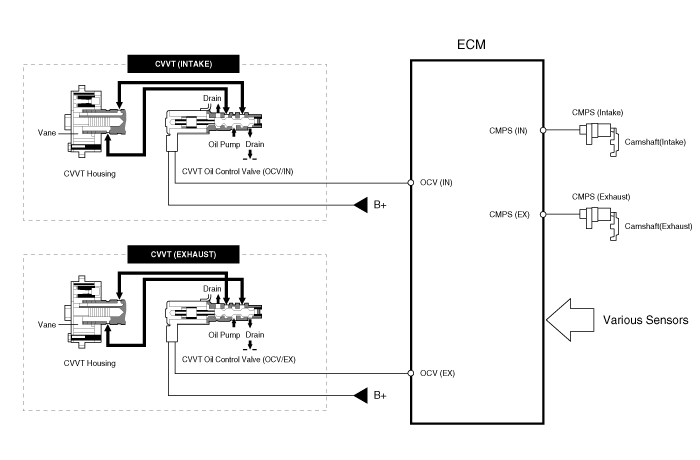 Kia Sorento: CVVT (Continuously Variable Valve Timing) System Description
Kia Sorento: CVVT (Continuously Variable Valve Timing) System Description
Second Generation XM (2011-2024) / Kia Sorento XM 2011-2024 Service Manual / Emission Control System / Exhaust Emission Control System / CVVT (Continuously Variable Valve Timing) System Description
Continuous Variable Valve Timing (CVVT) system advances or retards the
valve timing of the intake and exhaust valve in accordance with the ECM control
signal which is calculated by the engine speed and load.
By controlling CVVT, the valve over-lap or under-lap occurs, which makes
better fuel economy and reduces exhaust gases (NOx, HC). CVVT improves engine
performance through reduction of pump loss, internal EGR effect, improvement
of combustion stability, improvement of volumetric efficiency, and increase
of expansion work.
This system consist of
| - |
the CVVT Oil Control Valve (OCV) which supplies the engine oil
to the cam phaser or runs out the engine oil from the cam phaser in
accordance with the ECM PWM (Pulse With Modulation) control signal,
|
| - |
the CVVT Oil Temperature Sensor (OTS) which measures the engine
oil temperature,
|
| - |
and the Cam Phaser which varies the cam phase by using the hydraulic
force of the engine oil.
|
The engine oil getting out of the CVVT oil control valve varies the cam
phase in the direction (Intake Advance/Exhaust Retard) or opposite direction
(Intake Retard/Exhaust Advance) of the engine rotation by rotating the rotor
connected with the camshaft inside the cam phaser.

 Catalytic Converter Installation
Catalytic Converter Installation
1.
Install in the reverse order of removal.
...
 CVVT (Continuously Variable Valve Timing) System Operation Principle
CVVT (Continuously Variable Valve Timing) System Operation Principle
The CVVT has the mechanism rotating the rotor vane with hydraulic force
generated by the engine oil supplied to the advance or retard chamber in accordance
with the CVVT oil control valve con ...
See also:
Direct Electro Hydraulic Actuator Coupling Components
1. Coupling assembly
2. Input shaft
3. Pressure sensor
4. Extension wiring
5. Oil hydraulic Motor(Actuator)
...
Circuit Diagram
...
Hands Free Switch Inspection
1.
Check the handsfree remote control switch for resistance between
No.2 and No.5 terminals in each switch position.
[Call + Hang Up]
Switch
...
Copyright В© www.ksmanual.com 2014-2024
